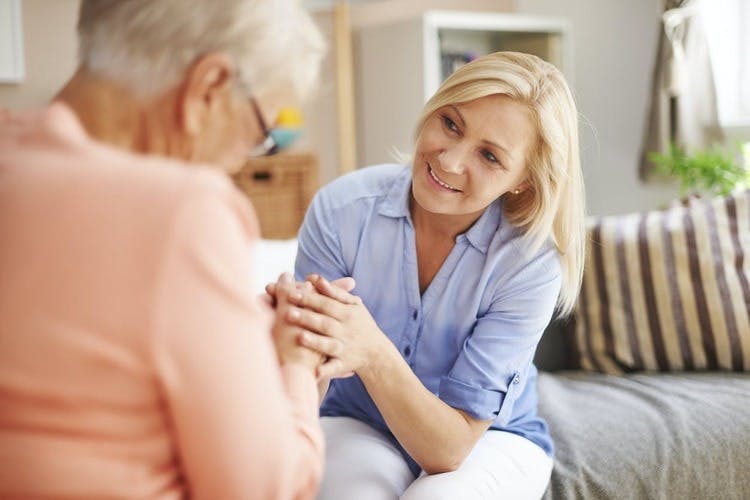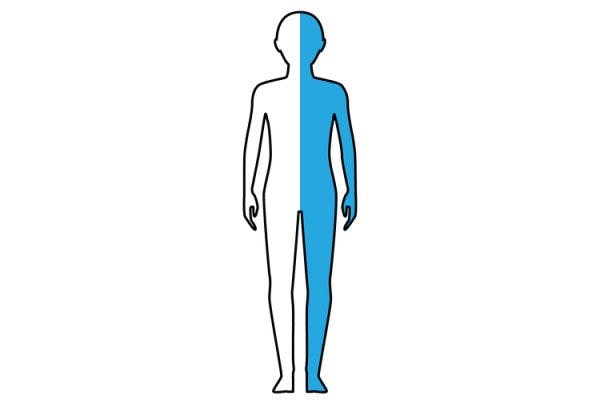Mood swings after stroke can be a normal part of the recovery process. This often occurs due to the many changes that have taken place in the brain. Moodiness can also be a sign of other complications such as pseudobulbar affect: a medical condition that triggers uncontrollable emotions.
While this effect can feel frustrating for both survivors and caregivers, it’s important to approach mood swings after stroke with interest, empathy, and compassion. To help you better understand your symptoms, we will discuss why mood swings may happen after stroke. Then, we will review different tips to cope with mood and behavior changes.
Causes of Mood Swings After Stroke
Generally, there are two main causes of mood swings after stroke: biological changes and lifestyle changes. Each requires a different treatment approach, so it’s important to talk with your doctor and therapists if you are struggling with intense mood swings. Your healthcare team can help you pinpoint your specific symptoms and provide interventions to help you feel your best.
Biological Causes of Mood Swings
The area of the brain affected by stroke determines the secondary effects a survivor will experience. For example, emotional disturbances are common after a right side stroke because our emotions are largely processed in the right hemisphere of the brain. Additionally, the frontal lobe and the limbic system play major roles in emotions. Tissue damage in these lobes can lead to poor emotional regulation and impulsivity.
When a stroke damages the emotional center of the brain, it can result in a condition known as pseudobulbar affect, which causes uncontrollable emotional outbursts. This takes place when the connection between the frontal lobe and the brainstem or cerebellum has been compromised. Pseudobulbar affect is common following a brainstem stroke or cerebellar stroke.
This condition can cause a survivor to demonstrate emotions that are inappropriate for the specific situation. Survivors with pseudobulbar affect may laugh at spilled milk, for example, or may find themselves suddenly crying for no apparent reason. They may also jump from one emotion to the next. This results in frequent, intense mood swings after stroke.
If changes in emotion are sudden, extreme, and don’t seem to align with the situations at hand, mood swings may signify the presence of conditions like pseudobulbar affect. Additionally, many other behavior changes can be present after stroke. Talk to your doctor or therapist about your concerns as they can provide treatment and helpful resources.
Lifestyle Causes of Mood Swings
If you are not experiencing pseudobulbar affect, then mood swings might be a secondary complication caused by lifestyle changes after stroke. If you are a caregiver, the best way to understand these changes is to put yourself in the shoes of a stroke survivor.
After a stroke, survivors can experience a variety of serious secondary effects that affect their independence or ability to participate in beloved hobbies. As a result, stroke survivors may struggle with mood swings, depression, and even PTSD. Additionally, grief after stroke and post-stroke anxiety are common among survivors and can have a major impact on quality of life.
Other contributing factors to a survivor’s mood swings after stroke can include a change in routine or sleep disturbances. Following a stroke, a survivor generally experiences a near-total upheaval of their normal schedule. Acute hospital stays, inpatient rehabilitation, and even the continuation of therapy at home can be taxing. As a result, survivors often experience chronic fatigue after stroke.
As the brain works to heal after stroke, sleep is incredibly important for recovery. However, studies estimate that around 50% of survivors are affected by a sleep disorder after stroke. Intense fatigue, schedule changes, and secondary effects often combine with these sleep disturbances to cause increased moodiness or mood swings after stroke.
It’s important to approach mood swings with compassion. Stroke recovery takes immense strength and it’s normal to struggle on some days. Mood swings should not be viewed as a sign of weakness. Rather, it’s a sign that physical or emotional recovery is needed. Thankfully, there are helpful steps you can take to lessen or avoid mood swings after stroke, which we will discuss next.
Overcoming Mood Swings After Stroke
Behavior changes and mood swings can sometimes feel uncontrollable for stroke survivors. However, the following steps can help improve mood swings after stroke for some. Since every stroke is different, every recovery will be different. Therefore, it’s important to keep seeking different methods of recovery until you find what works best for you.
Your therapy team is a valuable resource after stroke. Talk with your therapists about your symptoms and create achievable goals for your recovery. Your team can help you establish a recovery plan to help you address your physical goals as well as changes in your behavior or mood. To help you get started, here are 5 tips to cope with mood swings after stroke:
1. Train Your Brain
If your doctor has diagnosed you with pseudobulbar affect or depression, they may recommend medication such as antidepressants. These have been shown to help with pseudobulbar affect, even in low doses, and can also treat depression symptoms. However, medication isn’t the only hope for recovery.
Sometimes emotional disturbances go away on their own through a phenomenon known as spontaneous recovery. This involves neuroplasticity, which is your brain’s natural ability to heal, rewire itself, and learn new skills. Some secondary effects of stroke will correct themselves automatically over time through spontaneous recovery. However, others may require you to “train your brain” to control your emotions again.
One trick involves noticing your body posture when you have an intense mood swing, followed by shifting your posture. For example, if you are lying down when you feel your mood is changing, try sitting up right away. Notice if this shift changes your mood. This trick may help train your brain to notice mood swings and shift your perspective. Additionally, working on cognitive exercises may help attention, memory, and mood.
2. Participate in Talk Therapy
Stroke survivors are exactly that: survivors! A stroke is a life-threatening medical emergency that requires swift treatment and, in some cases, emergency surgery. Everything can change overnight, and this is something that everyone copes with differently.
If you’re struggling with your “new normal” and having difficulty navigating mood swings after stroke, participating in psychotherapy can help. There are many kinds of therapy, with cognitive behavioral therapy (CBT) being one of the most common. A therapist can help you cope with the emotional strain that stroke rehabilitation may cause. They will identify negative behaviors or thought patterns you may be experiencing and provide support.
In addition to providing helpful techniques to better manage your behaviors and emotions, they may also suggest other tips for managing mood swings. This can include strategies like meditation, deep breathing, or behavioral exercises. They may also encourage you to get connected with others via a stroke support group.
3. Learn About Positive Psychology
If you’re interested in an alternative or supplemental approach to medications, spend time learning about positive psychology. This aspect of psychology encourages a focus on the good events or aspects of your life to combat negative thought patterns. The book Healing & Happiness After Stroke digs deeper into that concept and is a helpful resource for survivors.
One example of positive psychology is gratitude journaling. By writing down the things you’re grateful for daily, you can train your brain to naturally gravitate towards gratitude. This seemingly small step can go a long way towards helping with mood swings after stroke.
4. Allow the Stages of Grief
Grief after stroke is common, but many survivors do not realize they are experiencing it. Many people assume that grief only happens when you lose a loved one, but this is inaccurate. Stroke survivors often experience grief when they sustain a considerable loss regarding their independence or identity.
It’s important to allow grief, not hurry it away. Grief is not a mood swing, but rather a process that may take a significant amount of time to navigate. The five stages of grief include denial, anger, bargaining, depression, and acceptance. The path to acceptance is not linear, as many people experience the stages of grief out of order or repetitively. For instance, someone may struggle with moving between anger and depression while they grieve.
It’s important to realize that this variety of emotions is the natural process of grief and should be experienced fully, not suppressed. The only way out is through. For more information, the book Healing & Happiness After Stroke goes through each stage of grief in greater detail.
5. Establish Healthy Habits
As we briefly mentioned earlier, the brain utilizes more energy to heal itself during stroke recovery. This reduces the available energy you have to move about your day and contributes to fatigue. Therefore, many survivors crave excessive sleep after stroke as the brain requires more rest to recharge.
Lack of sleep can lead to irritability, outbursts, decreased patience, and low-grade mood swings. This is why it is important to listen to your body during stroke recovery and to practice healthy sleep habits. Additionally, getting regular exercise after stroke and focusing on a healthy diet are ways to improve your mood and combat fatigue.
A recent research review demonstrated how exercise is a beneficial treatment for survivors experiencing depressive symptoms after stroke. Furthermore, we know that a healthy diet based on whole foods can positively affect mood. Try reviewing this list of foods that boost stroke recovery for inspiration.
It is important to be aware that excessive sleepiness and fatigue may be signs of depression. If you feel that you may be depressed, discuss this with your doctor to get help. Seeking guidance and support will allow you to receive the treatment you need for your unique symptoms.
Understanding Mood Swings After Stroke
Mood swings can be tricky to self-diagnose because they can be caused by biological or lifestyle changes, which are vastly different. They can even be caused by a combination of the two. Therefore, it is important to talk with your doctor about your symptoms to receive an accurate diagnosis.
Mood swings after stroke can be confusing and frustrating. Thankfully, there are treatments and techniques available to navigate this secondary effect. For example, your doctor may recommend medication to help cope with mood swings, depression, or anxiety. Talking with a licensed therapist can also be a valuable resource for survivors. A therapist can help you identify negative thought patterns and provide tips to counteract these.
While these may be effective, there are additional ways to help navigate mood swings, such as positive psychology. To help you get started with this, the book Healing & Happiness After Stroke discusses the process of emotional healing after stroke in greater detail. Furthermore, these techniques can be enhanced by prioritizing sleep, exercise, and a healthy diet.
Continue pursuing recovery day by day and make sure to set motivating goals that are meaningful to you. Mood swings may be frustrating, but they are a natural piece of the recovery journey for many. We hope this article has provided more information on mood swings after stroke and has inspired you to continue pursuing rehabilitation.










